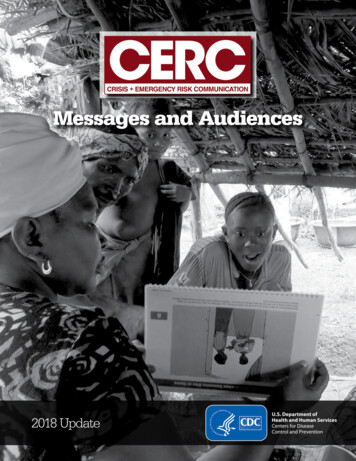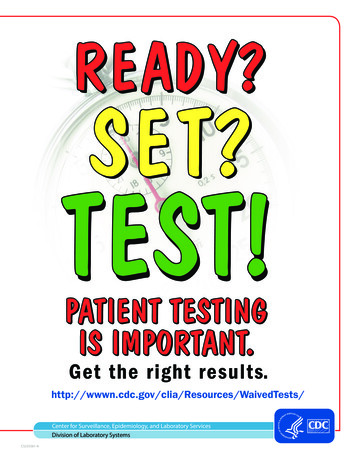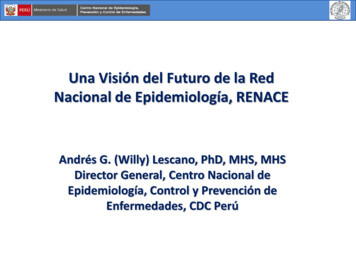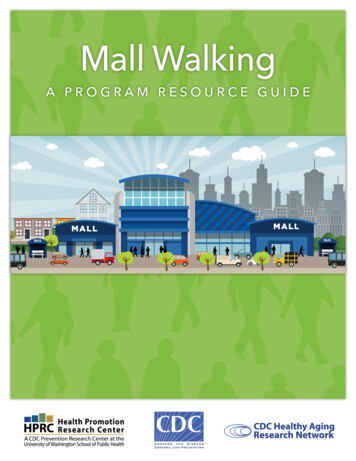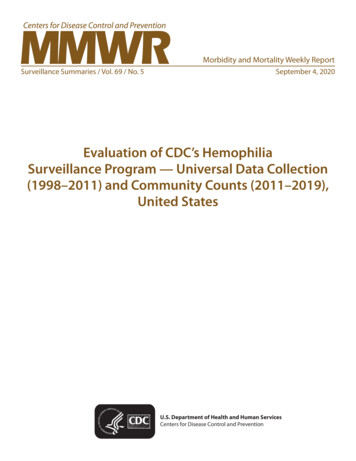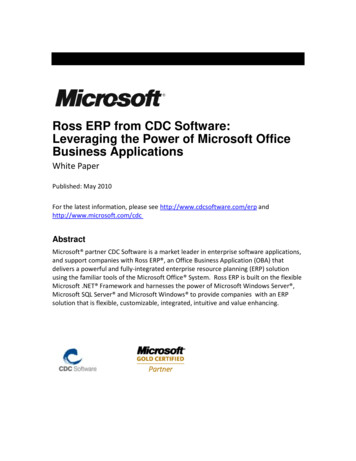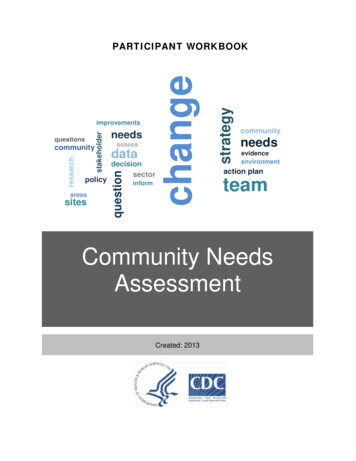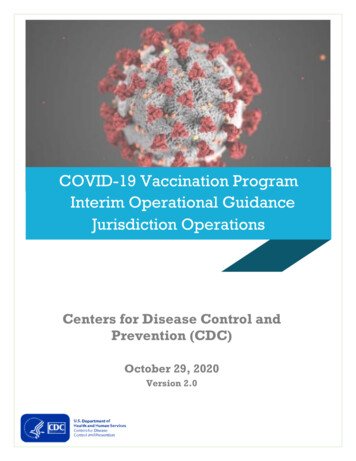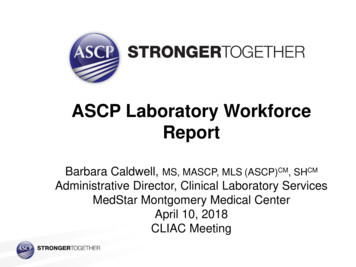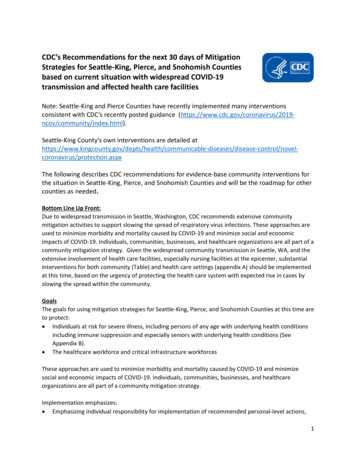
Transcription
National Healthand NutritionExamination SurveyDERMATOLOGYPROCEDURESMANUAL(Revised January 2004)
TABLE OF CONTENTSChapter1PageOVERVIEW OF THE NATIONAL HEALTH AND NUTRITIONEXAMINATION SURVEY .1.11.21.31.41.51.61.72341-1History of the National Health and Nutrition ExaminationPrograms .Overview of the Current NHANES .1-11-31.2.11-4Data Collection.Sample Selection.Field Organization for NHANES .Exams and Interviews in the Mobile Examination Center (MEC) .1-61-71-101.5.11.5.21.5.31.5.41.5.51.5.6Exam Sessions.Exam Team Responsibilities.Examination Components .Sample Person Remuneration .Report of Exam Findings .Dry Run Day .1-101-121-131-171-171-19Integrated Survey Information System (ISIS) .Confidentiality and Professional Ethics.1-191-19DERMATOLOGY OVERVIEW .2-12.12.22.3Overview of Dermatology Exam Component .General Overview of Skin .General Overview of NHANES Dermatology Examination .2-12-22-4DERMATOLOGY 3-23-93-10Pre-examination Procedures.Examination Procedures.Instruction for Image Capture and Quality Review .Image Retake and Exam Completion.EQUIPMENT .4-14.14.24-14-3Dermatology Equipment and Supplies .Equipment Set-Up and Operating Procedures .2
TABLE OF CONTENTS .64.2.74.2.84.34.44.556General Items .Consumables .Light-Related Items.Camera-Related Items .Securing the Cables.Camera Settings for Photography .Using the Autofocus.Image Transfer from Camera to Computer .4-34-54-64-104-194-204-224-24Equipment Maintenance .4-244.3.14.3.24.3.34.3.4Camera .IR Transmitter .Laser Pointer .Camera Stand .4-244-254-254-25Malfunctions and Troubleshooting .Dermatology Equipment Pack-Up Procedures .4-254-28ISIS DATA ENTRY .5-15.15.25.35.4General Screen Information.Vision Status/Jewelry Removal Screen .Capture Images Screen .Dermatology Exam Status Screen .5-15-25-45-7QUALITY CONTROL.6-16.1Quality Control Checklist ht Heads .Quality Control Image.Review of Images During the Examination.Review of Images During Analysis .Observation.Review of Exam Status.iii6-96-96-106-10(Revised January 2004)
TABLE OF CONTENTS (continued)List of AppendixesAppendixASummary of Dermatology Equipment Set-up Procedures .A-1List of FiguresFigure2-1The skin.2-3List of ExhibitsExhibit1-1Floor plan of the MEC .1-111-2MEC exams and rooms.1-111-3Examination components.1-143-1Image 1: “BACK WITH ELBOWS” .3-33-2Image 2: “INNER ARM” .3-53-3Image 3: “FRONT OF LEGS WITH HANDS” .3-63-4Image 4: “BACK OF LEGS WITH PALMS” .3-84-1Dermatology/Anthropometry room .4-14-2Light head .4-74-3Positioning the light head .4-84-4Light cables.4-84-5Light power pack .4-10iv
TABLE OF CONTENTS (continued)List of Exhibits (continued)ExhibitPage4-6Nikon DCS 760 digital camera .4-114-7Camera AC power cable .4-124-8Firewire cable .4-134-9Remote shutter release cable.4-144-10Connecting the IR cable to the camera .4-154-11IR transmitter .4-164-12LCD monitor.4-174-13Securing the cables .4-194-14Camera menu panel .4-216-1Background Screen QC Image.6-46-2Color Card QC Image .6-5v(Revised January 2004)
1. OVERVIEW OF THE NATIONAL HEALTH ANDNUTRITION EXAMINATION SURVEYThis chapter provides a general description of the health examination surveys conducted bythe National Center for Health Statistics (NCHS) and the current National Health and NutritionExamination Survey (NHANES). It also provides an overview of the tasks that staff perform during thesurvey.1.1History of the National Health and Nutrition Examination ProgramsThis NHANES is the eighth in a series of national examination studies conducted in theUnited States since 1960.The National Health Survey Act, passed in 1956, gave the legislative authorization for acontinuing survey to provide current statistical data on the amount, distribution, and effects of illness anddisability in the United States. In order to fulfill the purposes of this act, it was recognized that datacollection would involve at least three sources: (1) the people themselves by direct interview; (2) clinicaltests, measurements, and physical examinations on sample persons; and (3) places where persons receivedmedical care such as hospitals, clinics, and doctors’ offices.To comply with the 1956 act, between 1960 and 1984, the National Center for HealthStatistics (NCHS), a branch of the U.S. Public Health Service in the U.S. Department of Health andHuman Services, has conducted seven separate examination surveys to collect interview and physicalexamination data.The first three national health examination surveys were conducted in the 1960s:1.1960-62 – National Health Examination Survey I (NHES I)2.1963-65 – National Health Examination Survey II (NHES II)3.1966-70 – National Health Examination Survey III (NHES III)1-vi(Revised January 2004)
NHES I focused on selected chronic disease of adults aged 18-79. NHES II and NHES IIIfocused on the growth and development of children. The NHES II sample included children aged 6-11,while NHES III focused on youths aged 12-17. All three surveys had an approximate sample size of 7,500individuals.Beginning in 1970 a new emphasis was introduced. The study of nutrition and itsrelationship to health status had become increasingly important as researchers began to discover linksbetween dietary habits and disease. In response to this concern, under a directive from the Secretary of theDepartment of Health, Education and Welfare, the National Nutrition Surveillance System was institutedby NCHS. The purpose of this system was to measure the nutritional status of the U.S. population andmonitor nutritional changes over time. A special task force recommended that a continuing surveillancesystem include clinical observation and professional assessment as well as the recording of dietary intakepatterns. Thus, the National Nutrition Surveillance System was combined with the National HealthExamination Survey to form the National Health and Nutrition Examination Survey (NHANES). Foursurveys of this type have been conducted since 1970:1.1971-75 – National Health and Nutrition Examination Survey I (NHANES I)2.1976-80 – National Health and Nutrition Examination Survey II (NHANES II)3.1982-84 – Hispanic Health and Nutrition Examination Survey (HHANES)4.1988-94 – National Health and Nutrition Examination Survey (NHANES III)NHANES I, the first cycle of the NHANES studies, was conducted between 1971 and 1975.This survey was based on a national sample of about 28,000 persons between the ages of 1-74. Extensivedata on health and nutrition were collected by interview, physical examination, and a battery of clinicalmeasurements and tests from all members of the sample.NHANES II began in 1976 with the goal of interviewing and examining 28,000 personsbetween the ages of 6 months to 74 years. This survey was completed in 1980. To establish a baseline forassessing changes over time, data collection for NHANES II was made comparable to NHANES I. Thismeans that in both surveys many of the same measurements were taken in the same way, on the same agesegment of the U.S. population.1-vii
While the NHANES I and NHANES II studies provided extensive information about thehealth and nutritional status of the general U.S. population, comparable data were not available for manyof the ethnic groups within the United States. Hispanic HANES (HHANES), conducted from 1982 to1984, produced estimates of health and nutritional status for the three largest Hispanic subgroups in theUnited States—Mexican Americans, Cuban Americans, and Puerto Ricans—that were comparable to theestimates available for the general population. HHANES was similar in design to the previous HANESstudies, interviewing and examining about 16,000 people in various regions across the country with largeHispanic populations.NHANES III, conducted between 1988 and 1994, included about 40,000 people selectedfrom households in 81 counties across the United States. As previously mentioned, the health status ofminority groups is often different than the health status and characteristics of nonminority groups, soblack Americans and Mexican Americans were selected in large proportions for NHANES III. Eachgroup comprised 30 percent of the sample. NHANES III was the first survey to include infants as youngas 2 months of age and to include adults with no upper age limit. To obtain generalizeable estimates,infants and young children (1-5 years) and older persons (60 years) were sampled at a higher rate thanpreviously. NHANES III also placed an additional emphasis on the effects of the environment uponhealth. Data were gathered to measure levels of pesticide exposure, presence of certain trace elements inthe blood, and amounts of carbon monoxide present in the blood. A home examination was incorporatedfor those persons who were unable or unwilling to come to the exam center but would agree to anabbreviated examination in their homes.In addition to NHANES I, NHANES II, Hispanic HANES, and NHANES III, several otherHANES projects have been underway since 1982. These projects have been a part of the HANESEpidemiologic Follow-up Survey, a multiphase survey conducting follow-up interviews with theNHANES I population in order to provide longitudinal data on the health of the U.S. population.1.2Overview of the Current NHANESThis NHANES follows in the tradition of past NHANES surveys, continuing to be akeystone in providing critical information on the health and nutritional status of the U.S. population.1-viii
The major difference between the current NHANES and previous surveys is that the currentNHANES is conducted as a continuous, annual survey. Each single year and any combination ofconsecutive years of data collection comprises a nationally representative sample of the U.S. population.This new design allows annual statistical estimates for broad groups and specific race-ethnicity groups aswell as flexibility in the content of the questionnaires and exam components. New technologicinnovations in computer-assisted interviewing and data processing result in rapid and accurate datacollection, data processing, and publication of results.The number of people examined in a 12-month period will be about the same as in previousNHANES, about 5,000 a year from 15 different locations across the nation. The data from the NHANESare used by government agencies, state and community organizations, private researchers, consumergroups, companies, and health care providers.1.2.1Data CollectionData collected on the current NHANES survey began early in 1999 and will continue forapproximately 6 years at 88 locations (stands) across the United States. The survey was preceded by apretest in the spring of 1998 and a dress rehearsal was conducted in early 1999.Approximately 40,000 individuals of all ages in households across the U.S. will be randomlyselected to participate in the survey. The study respondents include whites as well as an oversample ofblacks and Mexican-Americans. The study design also includes a representative sample of these groupsby age, sex, and income level. Adolescents, older people, and pregnant women are also oversampled inthe current NHANES.The overall goals of the NHANES are to:!Estimate the number and percentage of persons in the U.S. population and designatedsubgroups with selected diseases and risk factor;!Monitor trends in the prevalence, awareness, treatment, and control of selecteddiseases;!Monitor trends in risk behaviors and environmental exposure;!Analyze risk factors for selected diseases;1-ix
!Study the relationships between diet, nutrition, and health; and!Explore emerging public health issues and new technologies.Selected persons are invited to take part in the survey by first being interviewed in theirhomes. Household interview data are collected via computer-assisted personal interviewing (CAPI) andinclude demographic, socioeconomic, dietary, and health-related questions. Upon completion of theinterview, respondents are asked to participate in a physical examination. The examination is conductedin a specially equipped and designed Mobile Examination Center (MEC), consisting of four trailers. TheMEC houses the state-of-the-art exam equipment and is divided into rooms to assure the privacy of eachstudy participant during the exams and interviews. The examination includes a physical and dentalexamination conducted by a physician and a dentist, laboratory tests, a variety of physical measurements,and other health interviews conducted by highly trained medical personnel.The household interviews and MEC exam combined will collect data in the followingimportant health-related areas:!Cardiovascular and respiratory disease;!Vision;!Hearing;!Mental illness;!Growth;!Infectious diseases and immunization status in children;!Obesity;!Dietary intake and behavior;!Nutritional status;!Disability;!Skin diseases;!Environmental exposures;!Physical fitness; and!Other health-related topics.1-x
1.3Sample SelectionA sample is defined as a representative part of a larger group. Since it is impossible tointerview and examine everyone in the U.S. for NHANES, a representative sample is taken of the U.S.population. By studying a representative sample of the population, it is assumed that the findings wouldnot have been too different had every person in the U.S. been studied. Because generalizations about thepopulation will be made, it is extremely important that the sample be selected in a way that accuratelyrepresents the whole population. Statisticians calculate the size of the sample needed and take intoconsideration the geographic distribution and demographic characteristics of the population, such as age,gender, race, and income.An introductory letter is sent to each household in the sample. A few weeks after the lettergoes out, interviewers visit each listed household and use carefully designed screening procedures todetermine whether any residents are eligible for the survey. If eligible residents are present, theinterviewer then proceeds to introduce the study, presents the Sample Person (SP) a survey brochure, andobtains a signed consent for the household interview. The brochure contains detailed information on thesurvey, the household interview, and the MEC examination.A signed consent form must be obtained from each eligible individual before the householdinterview can be conducted. A refusal to sign the consent form is considered a refusal to participate in thesurvey. After the interview is completed, the interviewer then explains the MEC exam, obtains anothersigned consent form for the MEC exam, and contacts the field office to schedule a MEC appointment forthe SP. All SPs aged
medical care such as hospitals, clinics, and doctors’ offices. To comply with the 1956 act, between 1960 and 1984, the National Center for Health Statistics (NCHS), a branch of the U.S. Public Health Service in the U.S. Department of Health and Human Services, has conducted seven separ

